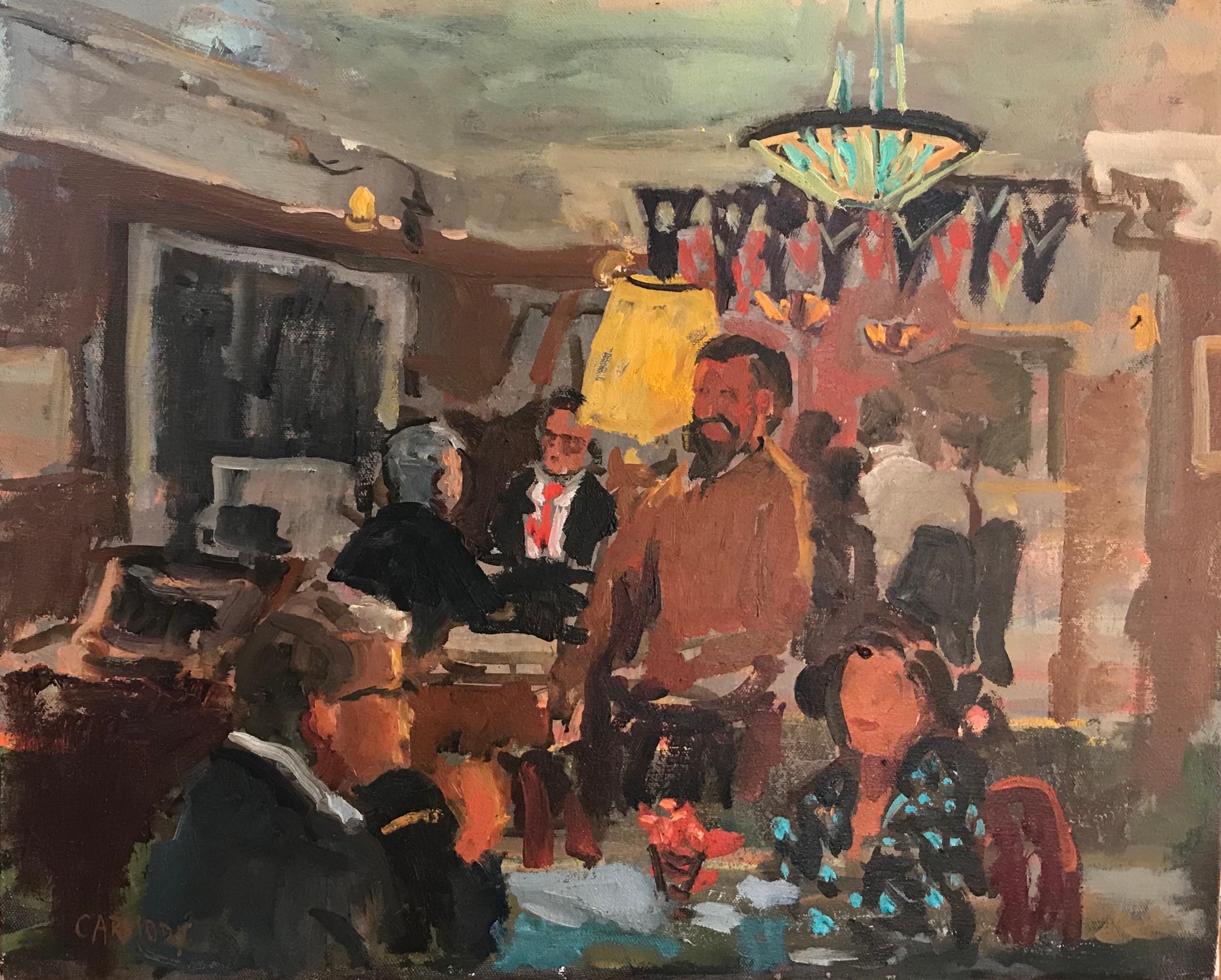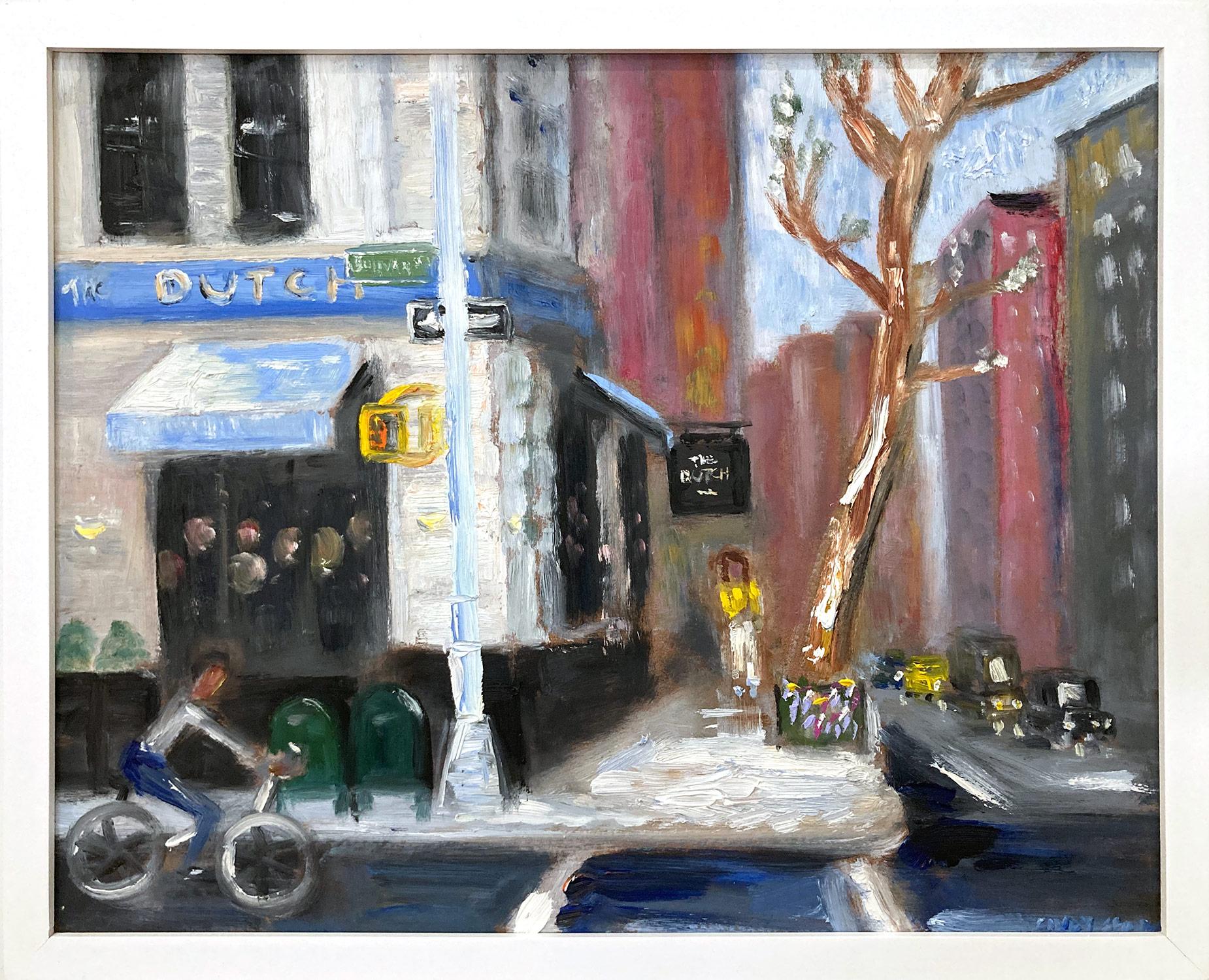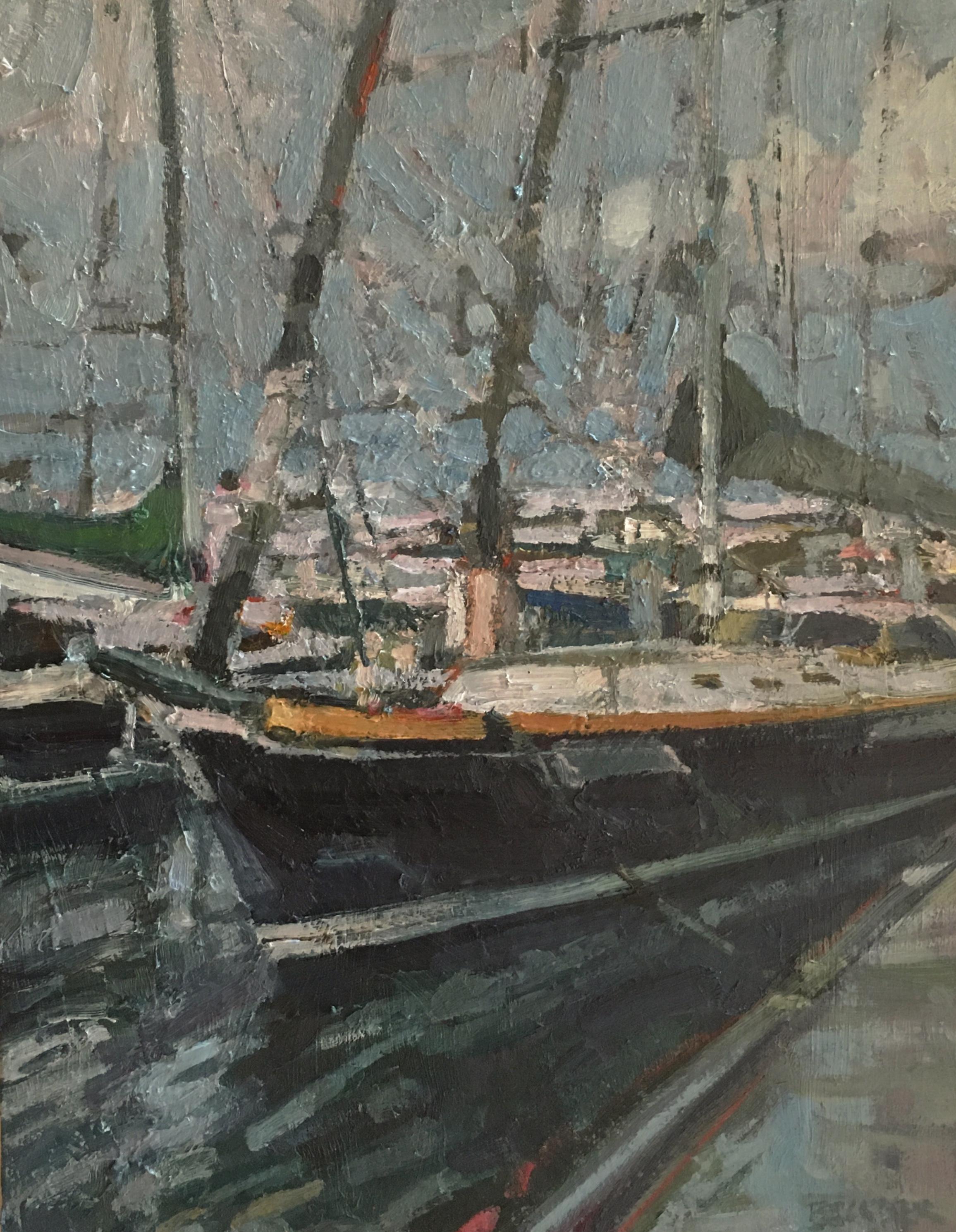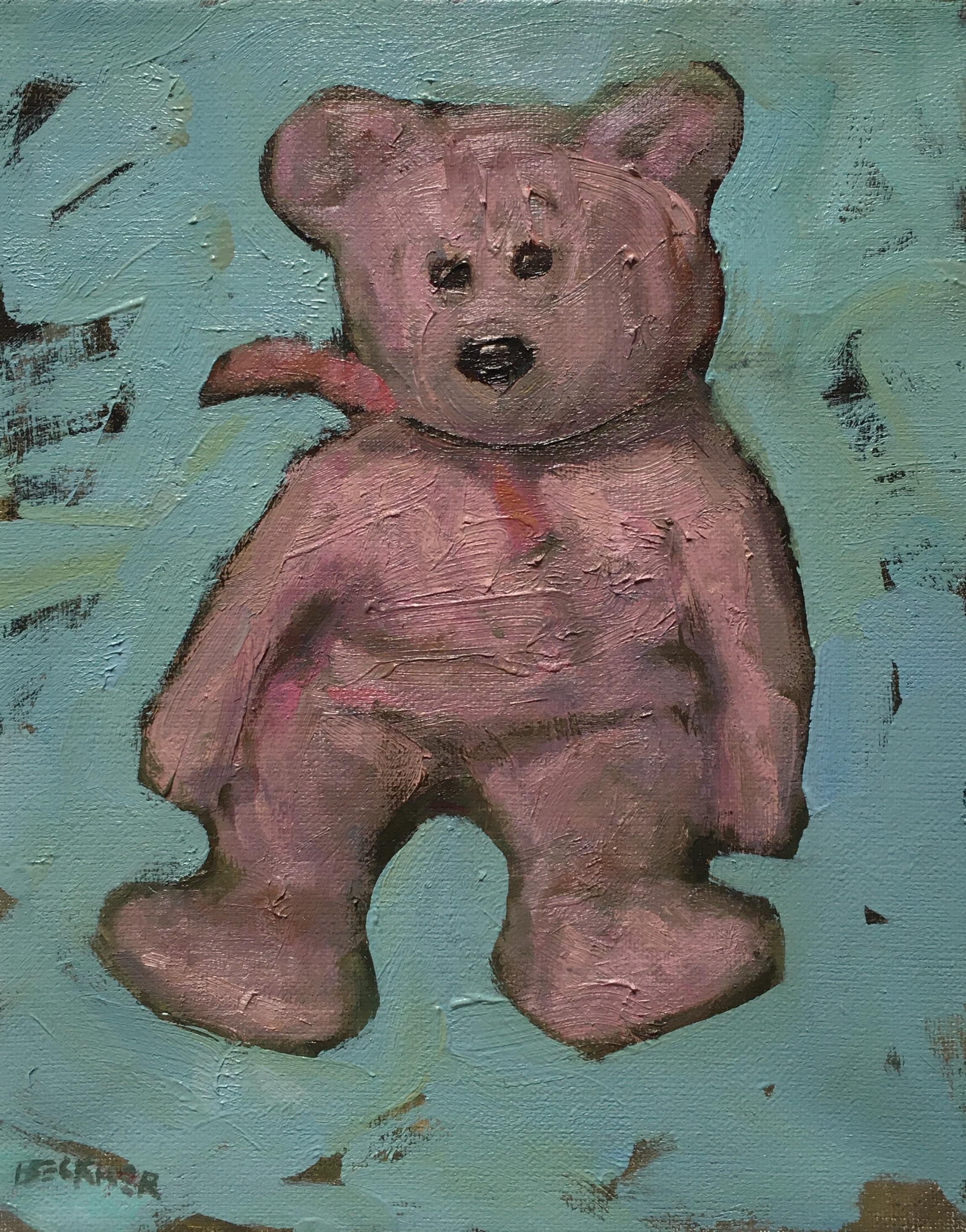Items Similar to Love Honor Obey?
Want more images or videos?
Request additional images or videos from the seller
1 of 6
Lon MegargeeLove Honor Obey?ca. 1940
ca. 1940
About the Item
Love Honor Obey?
Lon Megargee
ca. 1940
Oil on Board
Size: 19.75 x 26.75 inches
Frame: 26.75 x 33.75 inches
signed lower right
Painting is framed
Creator of the iconic logo for the Stetson Hat Company, " Last Drop From his Stetson", still in use today.
Fine Art Estate of Lon Megargee
At age 13, Lon Megargee came to Phoenix in 1896 following the death of his father in Philadelphia. For several years he resided with relatives while working at an uncle’s dairy farm and at odd jobs. He returned to Philadelphia in 1898 – 1899 in order to attend drawing classes at the Pennsylvania Academy of the Fine Arts. Back in Phoenix in 1899, he decided at the age of 16 to try to make his living as a cowboy. Lon moved to the cow country of Wickenburg where he was hired by Tex Singleton’s Bull Ranch. He later joined the Three Bar Ranch . . . and, after a few years, was offered a job by Billy Cook of the T.T. Ranch near New River. By 1906, Megargee had learned his trade well enough to be made foreman of Cook’s outfit. Never shy about taking risks, Lon soon left Cook to try his own hand at ranching. He partnered with a cowpuncher buddy, Tom Cavness, to start the El Rancho Cinco Uno at New River. Unfortunately, the young partners could not foresee a three-year drought that would parch Arizona, costing them their stock and then their hard-earned ranch.
Breaking with his romantic vision of cowboy life, Megargee finally turned to art full time. He again enrolled at the Pennsylvania Academy and then the Los Angeles School of Art and Design during 1909 – 1910. The now well-trained student took his first trip to paint “en plein air” (outdoors) to the land of Hopi and Navajo peoples in northern Arizona. After entering paintings from this trip in the annual Territorial Fair at Phoenix, in 1911, he surprisingly sold his first oil painting to a major enterprise – the Santa Fe Railroad . . . Lon received $50 for “Navajos Watching the Santa Fe Train.” He soon sold the SFRR ten paintings over the next two years. For forty years the railroad was his most important client, purchasing its last painting from him in 1953.
In a major stroke of good fortune during his early plein-air period, Megargee had the opportunity to paint with premier artist, William R. Leigh (1866 – 1955). Leigh furnished needed tutoring and counseling, and his bright, impressionistic palette served to enhance the junior artist’s sense of color and paint application. In a remarkable display of unabashed confidence and personable salesmanship, Lon Megargee, at age 30, forever linked his name with Arizona art history. Despite the possibility of competition from better known and more senior artists, he persuaded Governor George Hunt and the Legislature in 1913 to approve 15 large, historic and iconic murals for the State Capitol Building in Phoenix. After completing the murals in 1914, he was paid the then princely sum of roughly $4000. His Arizona statehood commission would launch Lon to considerable prominence at a very early point in his art career.
Following a few years of art schooling in Los Angeles, and several stints as an art director with movie studios, including Paramount, Megargee turned in part to cover illustrations for popular Western story magazines in the 1920s.
In the 1920s, as well, Lon began making black and white prints of Western types and of genre scenes from woodblocks. These prints he generally signed and sold singly. In 1933, he published a limited edition, signed and hard-cover book (about 250 copies and today rare)containing a group of 28 woodblock images. Titled “The Cowboy Builds a Loop,” the prints are noteworthy for strong design, excellent draftsmanship, humanistic and narrative content, and quality. Subjects include Southwest Indians and cowboys, Hispanic men and women, cattle, horses, burros, pioneers, trappers, sheepherders, horse traders, squaw men and ranch polo players. Megargee had a very advanced design sense for simplicity and boldness which he demonstrated in how he used line and form. His strengths included outstanding gestural (action) art and strong figurative work. He was superb in design, originality and drawing, as a study of his prints in the Hays collection reveals.
In 1944, he published a second group of Western prints under the same title as the first. Reduced to 16 images from the original 28 subjects, and slightly smaller, Lon produced these prints in brown ink on a heavy, cream-colored stock. He designed a sturdy cardboard folio to hold each set. For the remainder of his life, Lon had success selling these portfolios to museum stores, art fairs and shows, and to the few galleries then selling Western art.
Drawing on real working and life experiences, Lon Megargee had a comprehensive knowledge, understanding and sensitivity for Southwestern subject matter. Noted American modernist, Lew Davis (1910 – 1979), helped to explain the uniqueness, strength and character of Megargee’s art in a 1975 interview with an Arizona publication: “His restless independence as a man and an artist was clear then (before WWI) and remained so until his death. Always one characteristic stood out. He was indigenous. He belonged here. Not a carpetbagger with a paint box, or a disillusioned urbanite seeking a new life, but an artist who used what he knew and had lived to put down what he had seen.”
From the origins of his career in art, Lon Megargee had a strong sense of the importance and worthiness of contributions that had been made by Native Americans and Hispanics. Even when satirizing their actions and foibles, and those of his Anglo peers, Megargee in his art provided a fairness and balance to all creeds that was enlightened for its time.” Credit: Abe Hays
• Original works by Maynard Dixon, Lon Megargee, Ed Mell, Fritz Scholder, Bill Schenck, Bill Lesch, Luis Jimenez, Greg
Singley, Dan Budnik, and other 20th century Western, WPA and Contemporary Southwestern artists.
• The Fine Art Estate of Lon Megargee
• Vintage rodeo photography from our collection, hand colored, & reproduced in very large format, archival quality.
• Western Antiques and Mid Century Modern furnishing, lighting, lamps and chandeliers from the 40s, 50s and 60s
Michael Collier has over 40 years of fine art expertise and framing design. A custom frame maker offering hand carved, gilded frames, finished in wood tones and genuine gold leaf. Michael has designed original signature frames for artists, museums and premier dealers across the United States. Michael is one of a few people in Arizona who has mastered the skill of hand dying mats and French Matting.
We provide custom picture framing services to designers, museums, galleries, artists, and private collectors. Custom picture and art framing, including original hand carved, gilded frames, mirror frames and special custom leather frames. All picture framing is done to archival standards with a specialty in hand dyed mats and french matting. Custom mirror frames in traditional, contemporary or western styles, designed to fit your home or business. Signature frames for Lon Megargee, Maynard Dixon, Ed Mell and Greg Singley.
Disclaimer: Pricing and availability are subject to change without notice; please confirm the description of artwork or item.
Copyright
All images copyright © 2000-2023 by Michael Collier. Permission to reproduce photos and paintings on this website and online catalog secured by Michael Collier. All rights reserved. No portion of this website and online catalog may be reproduced in any manner whatsoever without written permission from Michael Collier, Collier Gallery Ltd.,
- Creator:Lon Megargee (1883 - 1960, American)
- Creation Year:ca. 1940
- Dimensions:Height: 19.75 in (50.17 cm)Width: 26.75 in (67.95 cm)
- Medium:
- Movement & Style:
- Period:
- Condition:
- Gallery Location:Phoenix, AZ
- Reference Number:1stDibs: LU2623212873922
About the Seller
No Reviews Yet
Vetted Seller
These experienced sellers undergo a comprehensive evaluation by our team of in-house experts.
1stDibs seller since 2023
- ShippingRetrieving quote...Ships From: Phoenix, AZ
- Return PolicyThis item cannot be returned.
More From This SellerView All
- Dragon Fly by Greg SingleyLocated in Phoenix, AZGreg Singley , born 1950- Artist Statement: When the sun sets in the desert South West, things appear. This is the nature of what touches me about that la...Category
2010s Contemporary Figurative Paintings
MaterialsOil
- Crow Before The Eagle by Greg SingleyLocated in Phoenix, AZGreg Singley , born 1950- Artist Statement: When the sun sets in the desert South West, things appear. This is the nature of what touches me about that la...Category
2010s Contemporary Figurative Paintings
MaterialsOil
- Regalia Before The Consul by Greg SingleyLocated in Phoenix, AZGreg Singley , born 1950- Artist Statement: When the sun sets in the desert South West, things appear. This is the nature of what touches me about that la...Category
2010s Contemporary Figurative Paintings
MaterialsOil
- Painted Lodge by Greg SingleyLocated in Phoenix, AZGreg Singley , born 1950- Artist Statement: When the sun sets in the desert South West, things appear. This is the nature of what touches me about that la...Category
2010s Contemporary Figurative Paintings
MaterialsOil
- Longhorns by Lon MegargeeLocated in Phoenix, AZLon Megargee 1883-1960 "Self Portrait" Wood block print Signed in plate, lower right Image size: 15.63 x 12 inches Frame size xx x xx inches Creator of S...Category
1930s American Impressionist Animal Prints
MaterialsScreen
- The Sheepherder by Lon MegargeeLocated in Phoenix, AZLon Megargee 1883-1960 "The Sheepherder" Wood block print Signed in plate, lower right Image size: 10 x 10 inches Frame size 22 x 22 inches Creator of Stetson's hat logo "Last Drop from his Hat" Lon Megargee 1883 - 1960 At age 13, Lon Megargee came to Phoenix in 1896 following the death of his father in Philadelphia. For several years he resided with relatives while working at an uncle’s dairy farm and at odd jobs. He returned to Philadelphia in 1898 – 1899 in order to attend drawing classes at the Pennsylvania Academy of the Fine Arts. Back in Phoenix in 1899, he decided at the age of 16 to try to make his living as a cowboy. Lon moved to the cow country of Wickenburg, Arizona where he was hired by Tex Singleton’s Bull Ranch. He later joined the Three Bar R. . . and after a few years, was offered a job by Billy Cook of the T.T. Ranch near New River. By 1906, Megargee had learned his trade well enough to be made foreman of Cook’s outfit. Never shy about taking risks, Lon soon left Cook to try his own hand at ranching. He partnered with a cowpuncher buddy, Tom Cavness, to start the El Rancho Cinco Uno at New River. Unfortunately, the young partners could not foresee a three-year drought that would parch Arizona, costing them their stock and then their hard-earned ranch. Breaking with his romantic vision of cowboy life, Megargee finally turned to art full time. He again enrolled at the Pennsylvania Academy of Art and then the Los Angeles School of Art and Design during 1909 – 1910. The now well-trained student took his first trip to paint “en plein air” (outdoors) to the land of Hopi and Navajo peoples in northern Arizona. After entering paintings from this trip in the annual Territorial Fair at Phoenix, in 1911, he surprisingly sold his first oil painting to a major enterprise – the Santa Fe Railroad . . . Lon received $50 for “Navajos Watching the Santa Fe Train.” He soon sold the SFRR ten paintings over the next two years. For forty years the railroad was his most important client, purchasing its last painting from him in 1953. In a major stroke of good fortune during his early plein-air period, Megargee had the opportunity to paint with premier artist, William R. Leigh (1866 – 1955). Leigh furnished needed tutoring and counseling, and his bright, impressionistic palette served to enhance the junior artist’s sense of color and paint application. In a remarkable display of unabashed confidence and personable salesmanship, Lon Megargee, at age 30, forever linked his name with Arizona art history. Despite the possibility of competition from better known and more senior artists, he persuaded Governor George Hunt and the Legislature in 1913 to approve 15 large, historic and iconic murals for the State Capitol Building in Phoenix. After completing the murals in 1914, he was paid the then princely sum of roughly $4000. His Arizona statehood commission would launch Lon to considerable prominence at a very early point in his art career. Following a few years of art schooling in Los Angeles, and several stints as an art director with movie studios, including Paramount, Megargee turned in part to cover illustrations for popular Western story magazines in the 1920s. In the 1920s, as well, Lon began making black and white prints of Western types and of genre scenes from woodblocks. These prints he generally signed and sold singly. In 1933, he published a limited edition, signed and hard-cover book (about 250 copies and today rare)containing a group of 28 woodblock images. Titled “The Cowboy Builds a Loop,” the prints are noteworthy for strong design, excellent draftsmanship, humanistic and narrative content, and quality. Subjects include Southwest Indians and cowboys, Hispanic men and women, cattle, horses, burros, pioneers, trappers, sheepherders, horse traders, squaw men and ranch polo players. Megargee had a very advanced design sense for simplicity and boldness which he demonstrated in how he used line and form. His strengths included outstanding gestural (action) art and strong figurative work. He was superb in design, originality and drawing, as a study of his prints in the Hays collection reveals. In 1944, he published a second group of Western prints under the same title as the first. Reduced to 16 images from the original 28 subjects, and slightly smaller, Lon produced these prints in brown ink on a heavy, cream-colored stock. He designed a sturdy cardboard folio to hold each set. For the remainder of his life, Lon had success selling these portfolios to museum stores, art fairs and shows, and to the few galleries then selling Western art. Drawing on real working and life experiences, Lon Megargee had a comprehensive knowledge, understanding and sensitivity for Southwestern subject matter. Noted American modernist, Lew Davis...Category
Early 20th Century American Impressionist Figurative Prints
MaterialsWoodcut
You May Also Like
- "Friday Night at the American Hotel" contemporary oil painting, dinner party funBy Kelly CarmodyLocated in Sag Harbor, NYAn oil painting of figures inside The American Hotel, in Sag Harbor, on a busy Friday Night. Kelly Carmody stood outside on the front porch of the Hotel, and painted the indoor scene...Category
2010s American Impressionist Figurative Paintings
MaterialsPanel, Oil
- "The Dutch" Plein Air with Figures & Cars Impressionistic Oil Painting on BoardBy Cindy ShaoulLocated in New York, NY"With shades of Pierre Bonnard’s Parisian street vistas and Edward Hopper’s New York shopfronts, American impressionist Cindy Shaoul’s oil paintings depict the much-loved locales and...Category
2010s American Impressionist Landscape Paintings
MaterialsBoard, Oil
- "Dock" Oil PaintingBy Jim BecknerLocated in Denver, COJim Beckner's (US based) "Dock" is an oil painting that depicts a sailboat and other boats in the distance docked and crowded together. Artist statement: Jim Beckner’s art vibrate...Category
2010s American Impressionist Figurative Paintings
MaterialsOil
- "Green I" Oil PaintingBy Jim BecknerLocated in Denver, COJim Beckner's (US based) "Green I" is an oil painting that depicts a dense lush forest and shrubbery with just a slice of sky peeking from behind the branches. Artist statement: J...Category
2010s American Impressionist Figurative Paintings
MaterialsOil
- "Pink Bear" Oil PaintingBy Jim BecknerLocated in Denver, COJim Beckner's (US based) "Pink Bear" is an oil painting that depicts a small pink bear toy with a light blue background Artist statement: Jim Beckner’s art...Category
2010s American Impressionist Figurative Paintings
MaterialsOil
- "Complete Thought" Oil PaintingBy John McLeodLocated in Denver, COJohn McLeod's "Complete Thought" is an original, handmade oil painting that depicts two cardinal birds facing each other as they perch on a tree branch.Category
2010s American Impressionist Animal Paintings
MaterialsOil, Panel
Recently Viewed
View AllMore Ways To Browse
Make Love
Love Is Vintage
Love Photo
Vintage Love Design
Love Signs Vintage
Love Bar
Love Forever
Love Vintage Photos
Vintage Love Scenes
Two Women Making Love
Western Vintage Cowboy Art
Native American Designers
Native American Story
Native American Women
Southwestern Native American Art
Vintage Railroad Art
American Western Movie
American Gold Picture Frame





